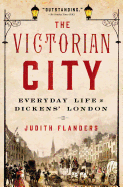
In The Victorian City, social historian Judith Flanders (The Invention of Murder) reminds us Charles Dickens was a journalist before he was a novelist. The London that stands at the hearts of his novels--so vibrant that it's almost a character in its own right--is not only a work of the imagination but the reportage of a great observer. From his first works to his last, Dickens recorded and reinvented the people of London's streets and the world they inhabited. His earliest readers recognized the jokes behind his often-sly accuracy; today, the lines between imagination and observation are less clear.
Using both Dickens's novels and a wide range of other contemporary accounts, Flanders attempts to look at the streets of London as they existed from 1812 to 1870, a period of tremendous transformation and growth. (The title Victorian City is a conscious misnomer. As Flanders points out, the great recorder of Victorian London spent almost half his life under the rule of Victoria's uncles.) Beginning with workers making their way through the city in the early morning and ending with the seedy side of Victorian nightlife, Flanders provides a detailed picture of both familiar and unfamiliar aspects of life in 19th-century London: markets, prisons, gin palaces, brothels, slums (known as "rookeries"), the mail stage and hackney cabs, and the health problems caused by overflowing cemeteries and overflowing cesspools. The Victorian City, filled with squalor, social injustice, larger-than-life characters and expansive prose, is Dickensian in every sense of the word. --Pamela Toler, blogging at History in the Margins

